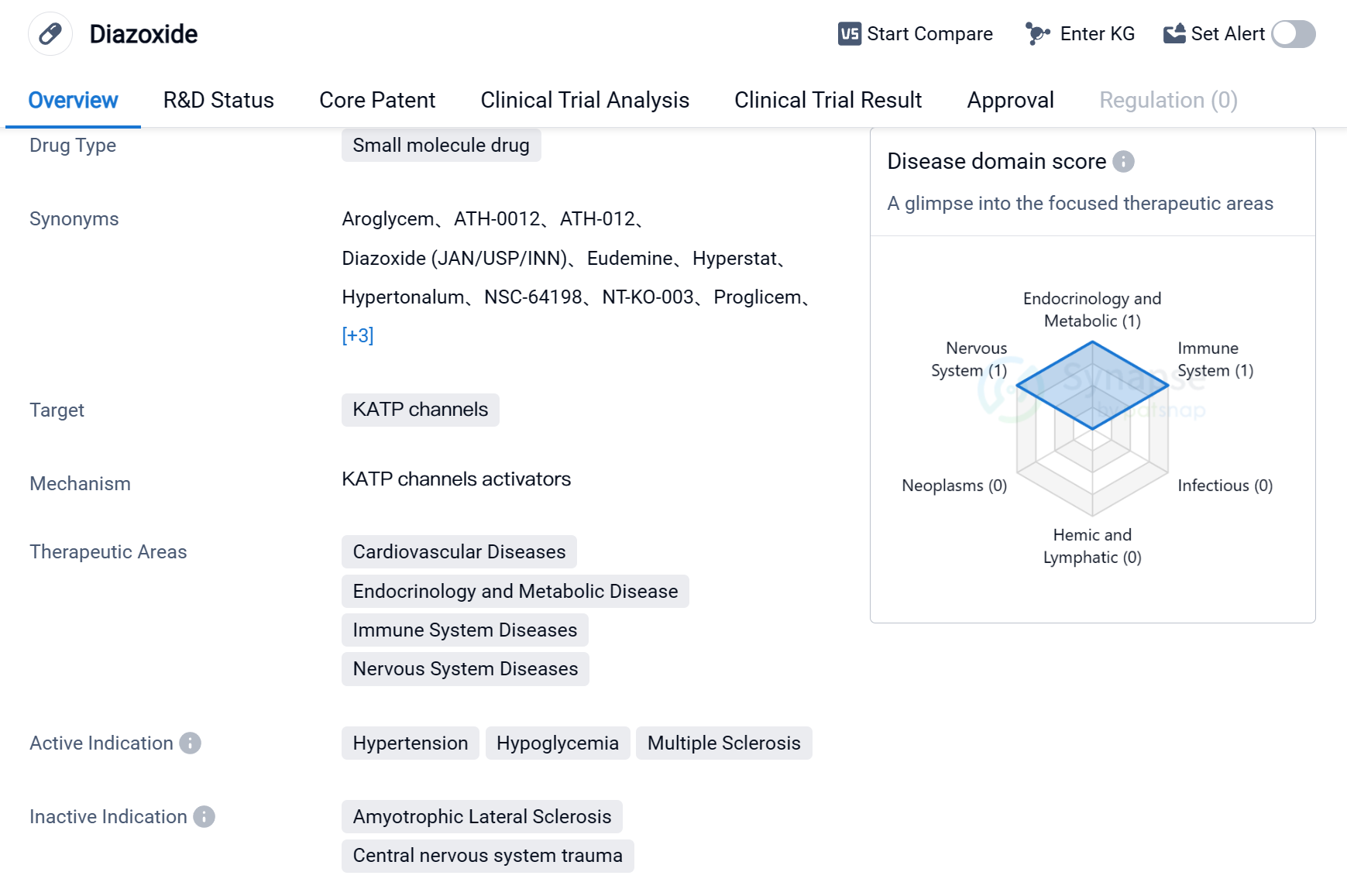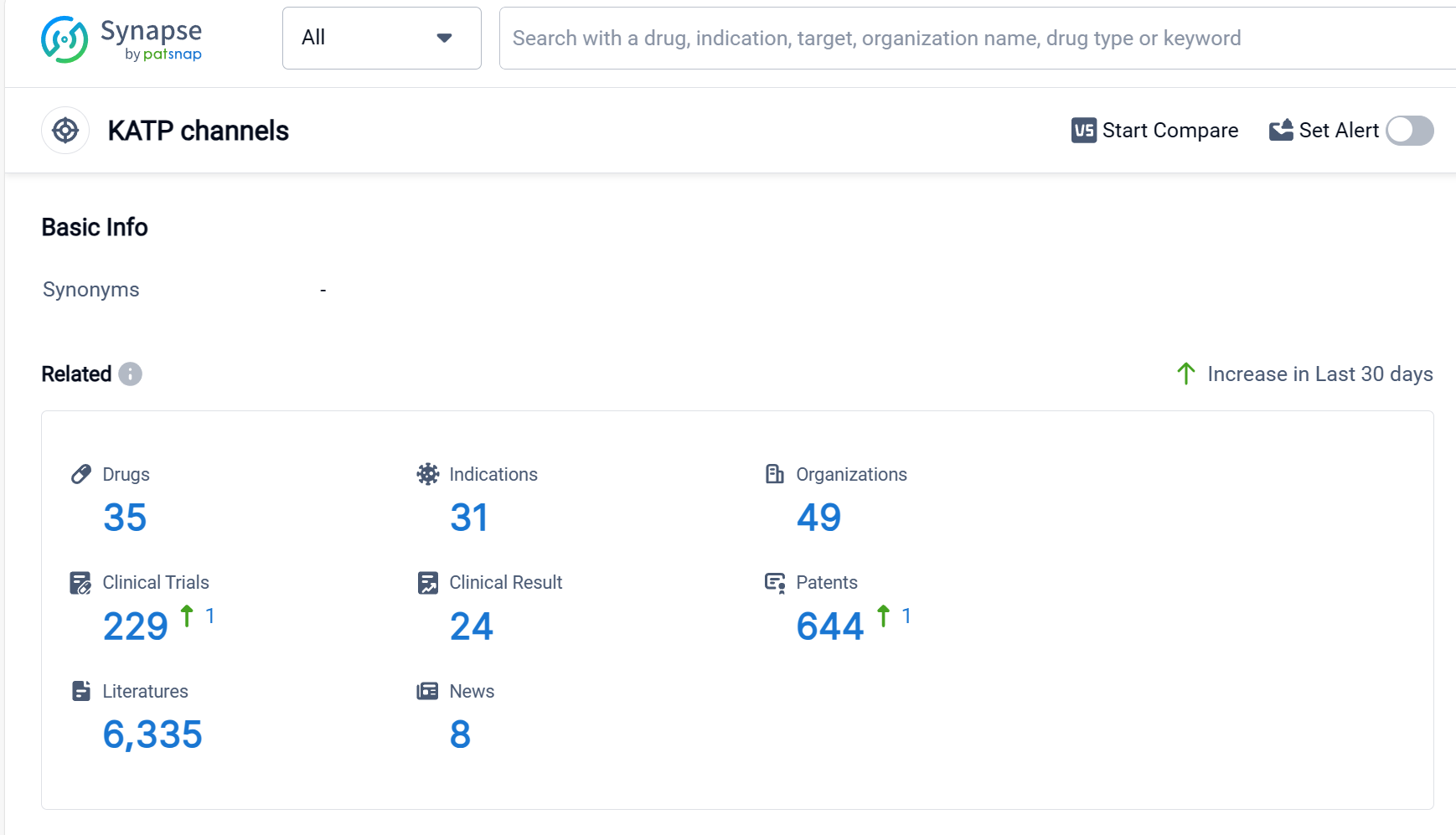Diazoxide Unveiled: A Detailed Overview of its Revolutionary R&D Breakthroughs
Diazoxide's R&D Progress
Diazoxide is a small molecule drug that primarily targets KATP channels. It has been approved for use in various therapeutic areas, including cardiovascular diseases, endocrinology and metabolic disease, immune system diseases, and nervous system diseases. The drug is indicated for the treatment of hypertension, hypoglycemia, and multiple sclerosis.
Diazoxide was developed by Merck Sharp & Dohme Corp., a renowned pharmaceutical organization. It received its first approval in the United States in January 1973, making it a well-established drug in the market. The approval in China also indicates its global recognition and acceptance.
As a small molecule drug, Diazoxide acts by targeting KATP channels. These channels play a crucial role in regulating various physiological processes, including insulin secretion, vascular tone, and immune response. By modulating these channels, Diazoxide can effectively manage conditions associated with cardiovascular diseases, endocrinology and metabolic disease, immune system diseases, and nervous system diseases.
The drug's active indications include hypertension, a condition characterized by high blood pressure, hypoglycemia, a state of low blood sugar levels, and multiple sclerosis, a chronic autoimmune disease affecting the central nervous system. Diazoxide's approval for these indications highlights its potential in managing these conditions and improving patient outcomes.
With its long history of approval and widespread use, Diazoxide has established itself as a reliable therapeutic option for healthcare professionals. The highest R&D phase of this drug is also approved.
👇Please click on the image below to directly access the latest data (R&D Status | Core Patent | Clinical Trial | Approval status in Global countries) of this drug.
Mechanism of Action for Diazoxide: KATP channels activators
KATP channels activators are a type of compounds or drugs that specifically target and activate ATP-sensitive potassium (KATP) channels. These channels are found in various tissues and play a crucial role in regulating cellular functions, particularly in response to changes in cellular energy levels.
From a biomedical perspective, KATP channels activators are important in the field of biomedicine as they have therapeutic potential in the treatment of various conditions. By activating KATP channels, these compounds can modulate cellular excitability, regulate insulin secretion in pancreatic beta cells, and protect tissues from ischemic damage.
In the context of drug development, KATP channels activators can be utilized to design medications that target specific diseases or conditions. For example, in the treatment of type 2 diabetes, KATP channels activators can enhance insulin secretion and improve glucose homeostasis. In addition, they have also been studied for their potential cardioprotective effects in conditions such as myocardial ischemia.
Overall, KATP channels activators are compounds that have the ability to activate ATP-sensitive potassium channels, and their therapeutic applications span various biomedical fields, including diabetes, cardiology, and neurology.
Drug Target R&D Trends for Diazoxide
According to PatSnap Synapse, as of 10 Sep 2023, there are a total of 35 KATP channels drugs worldwide, from 49 organizations, covering 31 indications, and conducting 230 clinical trials. The analysis of the target KATP channels reveals that several companies are growing rapidly under this target, with significant progress in their research and development efforts. Drugs targeting KATP channels have been approved for various indications, including Diabetes Mellitus, Type 2, Hypertension, Hypoglycemia, and Heart Failure. Small molecule drugs are the primary focus of research and development for this target. Japan, China, and the United States are the leading countries in terms of drug development under the target KATP channels, with China showing significant progress. The competitive landscape for target KATP channels is dynamic, with ongoing research and development efforts across multiple companies, indications, drug types, and countries/locations. The future development of target KATP channels holds promise for the advancement of treatments for various diseases and conditions.
👇Please click on the picture link below for free registration or log in directly if you have a freemium account, you can browse the latest research progress on drugs, indications, organizations, clinical trials, clinical results, and drug patents related to this target
Conclusion
In summary, Diazoxide is a small molecule drug developed by Merck Sharp & Dohme Corp. It targets KATP channels and has been approved for use in various therapeutic areas, including cardiovascular diseases, endocrinology and metabolic disease, immune system diseases, and nervous system diseases. The drug is indicated for the treatment of hypertension, hypoglycemia, and multiple sclerosis. Its first approval dates back to 1973 in the United States, and it has also received approval in China. Diazoxide's long-standing presence in the market and its active indications make it a valuable option for healthcare professionals in managing these conditions.






